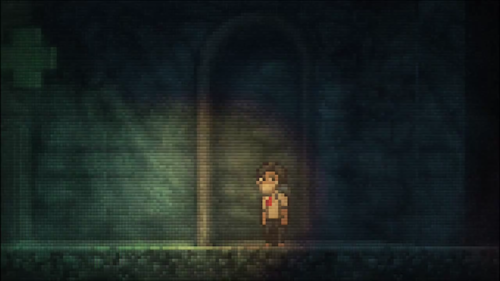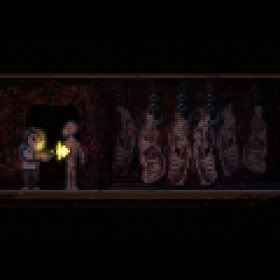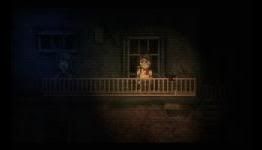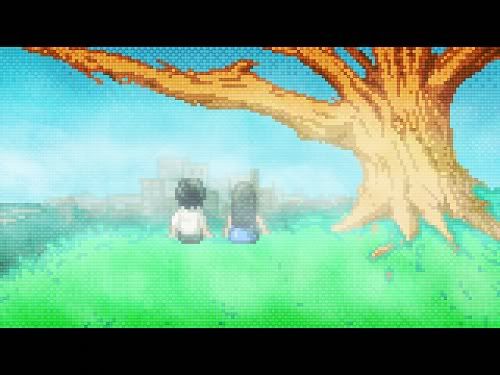The game was an emotionally and intellectually enthralling experience from start to finish. To be honest, I'm not even sure where to begin. I briefly considered not even writing this, since I'm kind of stumped on where to begin. Still, the game is too hidden and I loved it too much to let it go unsung.

Lone Survivor is a survival horror developed pretty much by one person, Jasper Byrne, over the course of a few years, and released under the name of Mr. Byrne's gaming company, Superflat. Jasper Byrne makes it no secret that he is a huge Silent Hill fan. With that in mind, Lone Survivor itself has often been called a 2D Silent Hill. After playing it, I dare say that this is a very apt description.
The game starts in medias res, with the nameless protagonist squatting in an empty apartment as a safe haven during an apparent zombie apocalypse. The world beyond his door is desolate and empty. The only populace is a sparse scattering of mutants. There is talk of a disease and hints of some kind of war, although exactly what happened to the world is never really explained.
The survivor, whose name "doesn't matter anymore" and is referred to only as you, has been sustaining himself within his apartment for and undisclosed amount of time. His supplies are dwindling fast, and his own psyche isn't faring much better. On his last leg, you gain control of him as he finally decides to venture out of isolation to scavenge for food and search for any remaining benevolent life.

The gameplay has you exploring the halls of the apartment, and eventually the streets of the surrounding city. In the same vein as any other adventure game, you make your way through dark areas looking for items to help sustain you and progress further. Sometimes you will need to find a key, or a doll, or some component to a machine in order to get to th enext few rooms. I wouldn't venture to call these puzzles, as they are all pretty straightforward. In almost every case, I had collected the necessary elements before even coming to whatever roadblock stood in my path.
In addition to the simple plot coupons, you also need to collect food and nurse your own mental health. There is just as much work in scavenging for supplies as there is for advancing the plot. These are two surprisingly deep and inter-connected systems that help to deepen the experience. If the survivor's sanity slips too far, he can hallucinate. To keep his mind from failing, the player must take care to keep him fed and well rested.
This is not as simple as just finding food and eating it. Nourishment is scarce to begin with, and since the survivor needs to eat every day, finding enough to satisfy your appetite is a constant concern in the back of your mind. Not all food is created equally, either. Jasper Byrne injected the food system with a sense of realism, requiring players to find necessary dishes to prepare food. Additionally, you can't just scarf down everything you find and expect the same results. Eating a couple chips will do little to quench a rumbling stomach. Eating lesser foods, like processed meat, can actually hurt his resolve rather than heal it. On the other hand, cooking a nice ham dinner or mixing up a fruit salad are tremendously beneficial.
Within this can be found the first, and possibly biggest, flaw in the game. The execution of the hunger/psychology elements works pretty well. There is no meter for these things, you are informed of how you are doing based on the survivor's thoughts. If he gets too tired or hungry, he will start complaining about it. This isn't what makes it bad, but the rate at which it happens. He seems to get hungry far too frequently. Since you're often trying to ration resources or don't have a filling food to cook, this can range from worrying to downright irritating. It can get very frustrating when you feed the survivor, walk to the next room, and have him start complaining again. The system itself is fine, but it would have benefitted from letting him go a little bit longer between meals without getting hungry.
Of course, eating and exploring aren't always easy when mutants can creep around any corner. Just like any survival horror game, enemies are powerful and spaced out to make confrontations suspenseful. The survivor's only tool of combat is a pistol obtain early in the game (despite eventually gaining access to an entire gun store, your character refuses to use any other firearms.) Enemies can be downed easier by shooting them in the head or made to back off by hitting their knees, although aiming can be difficult. The survivor is no Nathan Drake: he moves slowly with a gun, and getting a precise shot can be hard to pull off and requires enemies to get dangerously close. This may make combat sound clunky, but it's really just typical Silent Hill or old school Resident Evil gunplay mechanics translated to 16-bit. It serves to make the game more tense.

Fortunately, it's usually possible to stealth your way around enemies. Streets and hallways often have crevices that you can duck into and hide in the shadows. When used in conjunction with bait, most enemies can be circumvented without confrontation. Later in the game, you also gain access to flares, a powerful alternative to the gun which stun nearby monsters and allows you to run past unharmed. Although the non-violent approach sometimes takes longer and requires a little strategy, it is often preferable, since it not only preserves resources better, but going on killing sprees can have a negative influence on the survivor's mental health.
Visually, the game looks great. It is built in the same retro-throwback style that is popular among indie games these days. If that's what you like, then Lone Survivor does it perfectly. I should note here that the game runs in full screen unless you mess with the settings on the files in the directory, so everything looks kind of big on your monitor. It's not that bad, although the text is a little distorted because of it. Some people have also reported eye strain after playing for too long. I noticed after a particularly long play session that my vision was a little blurry when I turned it off, although the same might happen with any game.
The design harkens back to the Silent Hill influences. Everything has a gloomy feel to it, adding to the creepy atmosphere. A couple areas even mimic Silent Hill's famous rust and flesh-covered netherealm. In those games, it is explained away as the town's supernatural tendencies. Here, since we aren't told exactly what happened, these visuals have any explanation (until possibly the very end, depending what ending you get.) Coupled with the psychology factor, it makes the game even more atmospheric, as you can never be sure what is really happening or what might be just a figment of the character's ever weakening psyche.

The game is also quite dark, as is to be expected. This adds another element to the gameplay. You get a flashlight early on that is required to navigate some areas and examine some objects. You learn quickly to conserve it, though, since its power is not unlimitted. Flashlight batteries are some of the rarest items in the game, even more so than ammo and food, so smart use of the light is essential.
Just like any other survival game, you get a map to help you navigate. These must be found when you enter a new area, although they aren't hidden too badly. The map is one of the most useful tools in the game. However, there is something wonky about it that's hard to explain. The map is marked fine and does its job well. The problem is that it always seems to be oriented in one direction, while actually walking around changes the character's orientation based on where he is.
Say for example that when you open the map, you decide to head west. The character might be in the south corridor, with the camera facing outward. You may walk to the right expecting to head east, but due to the way the map is facing, that way is actually west, and you end up in the wrong direction. I got into the habbit of checking the map every time I entered a door, then walking a few feet one way and checking again, just to ensure that I had my sense of direction down. On top of that, if you are standing next to multiple doors, you may end up repeatedly going through the wrong ones just because you can't figure out which is which on the map. This is only a minor issue, but it is notable nonetheless.
If you care, there isn't much in the way of enemy variety. This might seem nitpicky, and it is, because it really doesn't make much of a difference. Still, I noticed it. There are two "boss" characters that show up one time each. Other than that, there are only two types of monsters: a tall, skinny thing with tentacles (somebody on TV Tropes compared it to a naked Slenderman) and pregnant-looking blob thing. There are a couple variants on the skinny one in terms of its behavior, but they all look identical. Again, this is a very minor issue, and doesn't really harm the game. I just think it would have spiced things up if one of the skinny monster's variations had a different design.

All of these factors lend themselves well to the creepy atmosphere of the game. And that is no lie. Don't let the graphics fool you, Lone Survivor is every bit as unsettling as its inspiration Silent Hill. There are a couple jump scares which make your heart race. They are used sparingly and thus have a greater effect. The atmosphere comes from feeling truly alone, not knowing what is real or not, and not having a clue what might be around the next corner. Enemies are legitimately scary and a dangerous threat. All of the different resources that must be rationed and nursing his mental health contantly wear in the back of your mind. It makes Lone Survivor significantly atmospheric.
The other characters don't do much to ease the pain. They are few and far between. Rather than being survivors, most are ghost-like entities that seem to have some kind of connection with the survivor that they never quite reveal, making the player wonder if they were ever there or are just more hallucinations.
Some of the game's marketing mentions multiple endings in a way that suggests a wide-open experience. I want to clear up right now that there are no branching paths. The game is extremely linear. The things that change the ending are how you have the character act in certain situations. Use of drugs, choosing how often to fight enemies, eating the right food, petting a lost cat, or encouraging a wounded shopkeeper to keep his chin up. They are small actions that shape the character's personality more than his path to survival.

To put it bluntly, I loved this game. It has so much atmosphere and substance that it draws you in emotionally. I could talk all day about what works and what doesn't. There are so many things that stick with you, from its set pieces to its visuals to tiny moments of compassion between characters. Lone Survivor is one of the most emotionally involving games I've played in a long time and enthralled me enough to stay in my head hours after I stopped playing for the night.
I recieved the game as part of the Humble Indie Bundle, and it was one of the best deals I've ever gotten on a game. It currently goes for $9.99 on Steam. I wouldn't pay much more than that, but it is worth that if you're interested.
Lone Survivor has been called a 16-Bit Silent Hill. Don't let the graphics or the inspiration give the wrong impression. It is every bit as frightening and emotional as its inspiration. Even the game's most glaring flaws do little to detract from the overall package, making Lone Survivor an engaging experience that should not be missed by any gamer with a taste for the sublime. If I wore a hat, I would take it off to Mr. Jasper Byrne.
No comments:
Post a Comment